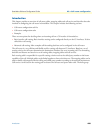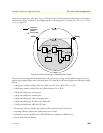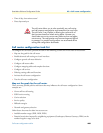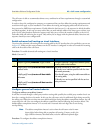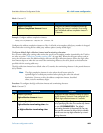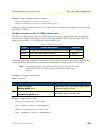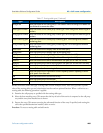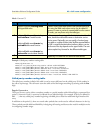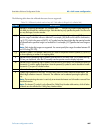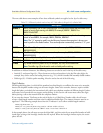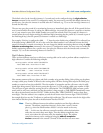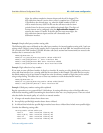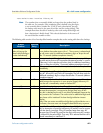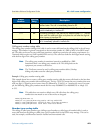
Call router configuration task list 465
SmartWare Software Configuration Guide 40 • Call router configuration
Besides the header (name and type) a routing table contains multiple entries. Each entry specifies a specific
value of the routing table type and a destination interface and an optional function. When a call arrives at a
routing table, the following procedure is applied:
1. Examine the call property as specified with the routing table type.
2. Select the best matching entry. This means that the key of each of the entries is compared to the call prop-
erty and the entry that matches best is chosen.
3. Execute the entry. This means executing the referenced function of the entry if specified, and routing the
call to the specified destination interface, table or service.
Procedure: To create a routing table and add entries
calling-e164 Route calls based on the calling party E.164 number. Entries of calling-e164 tables can
use wildcards to summarize routes.
called-type-of-number Route calls based on the called party number type. ISDN distinguishes different type of
numbers.
calling-type-of-number Route calls based on the calling party number type. ISDN distinguishes different type of
numbers.
called-numbering-plan Route calls based on the called party numbering plan. ISDN distinguishes different
numbering plans.
calling-numbering-plan Route calls based on the calling party numbering plan. ISDN distinguishes different
numbering plans.
called-name Route calls based on the display name of the called party.
calling-name Route calls based on the display name of the calling party.
called-ip Route calls based on the signaling IP address of the destination VoIP peer.
calling-ip Route calls based on the signaling IP address of the origination VoIP peer.
called-uri Route calls based on the URI of the destination VoIP peer (for SIP calls: the To-URI).
calling-uri Route calls based on the URI of the origination VoIP peer (for SIP calls: the From-URI).
calling-pi Route calls based on the presentation indicator.
calling-si Route calls based on the screening indicator.
itc Route calls based on the information transfer capability (bearer capability) to distin-
guish speech from data calls.
time Route calls based on the current time of day. .
date Route calls based on the current date.
day-of-week Route calls based on the current day of week.
Table 17. Routing table types (Continued)
Type Description




